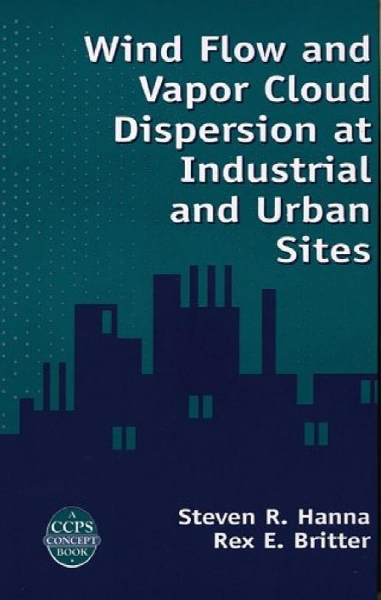Wind flow and vapor cloud dispersion at industrial and urban sites
- نوع فایل : کتاب
- زبان : انگلیسی
- مؤلف : Steven R Hanna; R E Britter
- ناشر : New York : Center for Chemical Process Safety of the American Institute of Chemical Engineers
- چاپ و سال / کشور: 2002
- شابک / ISBN : 9781591245759
Description
Contents Preface ix Acknowledgments xi List of Symbols xiii 1 Introduction 1 1.1. Background 1 1.2. Objectives of This Book 3 1.3. Overview 4 1.4. Definition of Scenarios and Modeling Scales 6 2 Overview of Meteorology and Atmospheric Dispersion 9 2.1. Definitions of Concepts and Terms 10 2.2. Engineering Background 25 2.3. Survey of Currently Available Methods for Classifying Dispersion Coefficients for a Variety of Surface Types 29 2.3.1. Introduction to Discussion of Effects of Surface Features 29 v 2.3.2. Use of a Simple Gaussian Dispersion Model to Understand the Effects of Roughness 31 2.3.3. Situations Where Winds, Stability and Underlying Terrain Vary in Time and/or Space 33 2.3.4. Methods for Accounting for Surface Roughness Length and Displacement Length in Dispersion Models 34 2.4. Survey of Experiments Showing Effects of Surface Roughness Obstacles on Dispersion 37 2.4.1. Dispersion of Clouds with Mass-Weighted Mean Heights Greater Than the Roughness Obstacle Height, Hr 37 2.4.2. Dispersion of Clouds with Mass-Weighted Mean Heights Less Than the Roughness Obstacle Heights, Hr 40 3 Methods for Characterizing the Effects of Surface Roughness Obstacles on Flow 47 3.1. Required Flow Characteristics for Input to Transport and Dispersion Models 48 3.2. Consideration of Flow Above and Below the Tops of the Obstacles 50 3.3. Flow above the Surface Roughness Obstacles 53 3.3.1. Definition of Surface Roughness Length, zo, and Displacement Length, d, as They Relate to Flow Characteristics Such as Wind Speed 54 3.3.2. Methods for Estimating zo and d from Wind Observations 56 3.3.3. Size of Surface Area that Influences Flow at a Given Height 65 3.3.4. Estimation of zo and d Based on Knowledge of Surface Roughness Obstacles’ Dimensions and Geometric Relations (the Morphological Method) 68 3.3.5. Overview of Land Use Category Methods for Estimating zo and d 79 3.3.6. Estimation of zo for Surface Conditions Varying in Space 82 3.4. Flow Through an Obstacle Array 87 3.4.1. Extent of the Roughness Sublayer 90 3.4.2. Wind Velocity Fields within and Near Obstacle Arrays 91 3.4.3. Model Comparison with Experimental Data 97 3.4.4. The Turbulence Field within the Obstacle Array 99 3.4.5. Extensions to Other Effects within the Obstacle Array 102 3.4.6. Summary of Recommendations for Wind Speed and Turbulence within Obstacle Arrays 104 vi Wind Flow and Vapor Cloud Dispersion at Industrial and Urban Sites 3.5. Summary of Recommended Methods for Estimating zo, d, and Flow Characteristics Such as Wind Profiles, Friction Velocity (u*), and Turbulence Velocities in Urban and Industrial Areas 104 3.5.1. Definition of Region of Interest (from Source to Receptor) 105 3.5.2. Determination of zo and d 107 3.5.3. General Simple Formulas for u*, u(z), and Turbulent Velocities 111 3.5.4. Selection of an Appropriate Mean Wind Speed and Stability 112 3.5.5. Estimates of Urban and Industrial Geometric Parameters Hr, λf, and λp Using the ROUGH Code 113 3.5.6. Range of Uncertainty in Estimates of zo, d, u*, u(z), and Turbulent Velocities 115 4 Integration of Roughness into Dispersion Models 117 4.1. Objectives and Fundamental Physical Concepts 117 4.2. Dispersion Models for Clouds Extending Above Hr 121 4.2.1. Introduction to General Characteristics of Models 121 4.2.2. Summary of Dispersion Experiments over Rough Surfaces 122 4.2.3. Gaussian Plume and Puff Model 123 4.3. Dispersion Models for Clouds below Hr 126 4.3.1. The Cloud Velocity, ue or uavg, below Hr 128 4.3.2. The Vertical Plume Dimension σz below Hr 128 4.3.3. The Lateral Plume Dimension σy below Hr 131 4.3.4. The Along-Wind Puff Dimension σx below Hr 133 4.3.5. The Effect of uc, σx, σy and σz on the Concentration at Heights below Hr 134 4.3.6. Extension to Positively and Negatively Buoyant Releases below Hr 136 4.4. Transition Methods for Clouds of Height Close to Hr within the Urban Roughness Sublayer 136 4.5. Summary and Recommendations 140 4.5.1. Dispersion Models for Clouds Extending above Hr 140 4.5.2. Dispersion Models for Clouds Released above or Near Hr 140 4.5.3. Dispersion Models for Clouds below Hr 141 4.5.4. Dispersion Models for Scenarios Where the Upwind and Downwind Roughness Is Different 141 Contents vii 4.5.5. Dispersion Models for Clouds Released Upwind of the Roughness and Traveling into and through the Roughness 142 5 Worked Examples of Calculations of Surface Roughness Length for Seven Industrial and Urban Scenarios 143 5.1. Case 1: Small (18 m by 24 m) Industrial Plant 144 5.2. Case 2: A Group of Industrial Warehouses Covering a 250 m by 250 m Area 147 5.3. Case 3: Medium-Sized (400 m by 400 m) Refinery 150 5.4. Case 4: Typical Urban Area (Chicago) 153 5.5. Case 5: Industrial Plant (Case 3) in Chicago Urban Area 155 5.6. Case 6: Industrial Plant from Case 3 Located on a Peninsula 159 5.7. Case 7: Large 4 km by 4 km Refinery in a Desert 163 5.8. Summary of Seven Cases Used for Worked Examples 165 Appendix Text Files for CD-ROM with zo Estimation Codes 167 ROUGH-GEOMETRY User’s Guide 170 ROUGH-ZO User’s Guide 178 References 181 Glossary 191 Index 203


